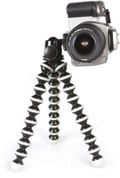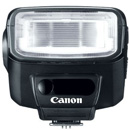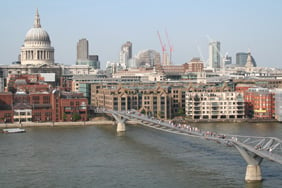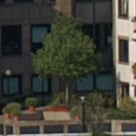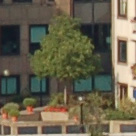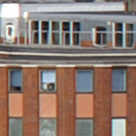Canon EOS-350D / Digital Rebel XT with 18-55mm f3.5~5.6 II EF-S lens
-
-
Written by Gordon Laing
In depth
Canon EOS 350D / Rebel XT design
Physically speaking, the 350D is a seriously compact digital SLR. At 127 x 94 x 64mm, it’s only fractionally larger than the tiny Pentax *istDL, which is the smallest in its class. Fit a battery and standard lens though and the 350D can comfortably claim the prize of lightest digital SLR at just 724g for the complete working kit. The body, available in black or silver finish, is pictured here on the far left, next to Konica Minolta’s Dynax 5D, Nikon’s D50 and the Pentax *istDL.

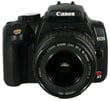 |
Placed alongside the earlier 300D, the difference in size is immediately apparent. The grip’s shrunk and from the front the 350D looks much more symmetrical. While some will love the fact a digital SLR can now just about squeeze into a large coat pocket, others will find the smaller body less comfortable to hold. It all depends on the size of your hands and what you’re used to. If your heart’s set on the 350D, but it’s just a wee bit on the small side, consider buying the optional battery grip. It provides a much greater surface to hold onto and also includes portrait aspect controls.
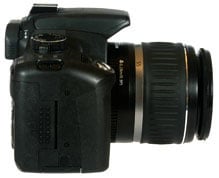 |
Much of the weight reduction is thanks to a considerably smaller battery than the 300D. This immediately raises alarm bells to battery life, but the new lower-power image processor compensates and as a result you’ll still enjoy as many shots on a single charge. During one test period, the 350D battery grip with two batteries was good for around 900 shots taken predominantly with hungry IS lenses.
Despite its smaller size and weight, the 350D feels much better built than the often creaky 300D. It’s no-where near the same league as the 20D, but a great improvement none-the-less. Many of the controls feel better too, especially the tactile mode dial.
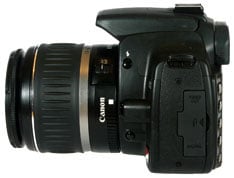 |
Like the 300D, the mode dial is split between traditional creative modes and automatic presets. On the creative side there’s the usual Program, Manual, Shutter and Aperture Priority, along with Auto Depth-of-field. Shutter speeds range from 1/4000 to 30 seconds plus Bulb in third-stop increments; it’s possible switch these to half-stop increments in a custom menu. The automatic preset modes consist of Portrait, Landscape, Close-up, Sports, Night, Flash-off and the fully automatic Canon green rectangle.
Strangely though several controls have been relocated for no apparent reason. The drive button has been moved from the top of the 300D to the right of the status display on the 350D. This seems no big deal until you press the shutter release and find you’ve inadvertently activated the self-timer option with your nose – it sounds unlikely, but we’ve witnessed several people complain of the same thing. This control would have been better left at the top, or only used in combination with a turn of the dial. The ISO setting which used to be shown on the status screen has also now inexplicably moved to main colour screen, which isn’t as easy to read under bright conditions.
One of the greatest complaints about the earlier 300D was its lack of custom functions, several of which could be unlocked using a hacked firmware update. Thankfully Canon’s officially implemented nine custom functions on the 350D, including the ability to activate mirror lockup or rear curtain flash.
In addition the main menus offer the choice of sRGB and Adobe RGB colour spaces, white balance bracketing and a black and white mode with the choice of four digital colour filters. Like the 20D, the built-in flash now pops-up a little higher and the 350D also supports E-TTL II for through-the-lens exposure control. And at long last there’s flash compensation controls.
Canon EOS-350D / Rebel XT composition and screen
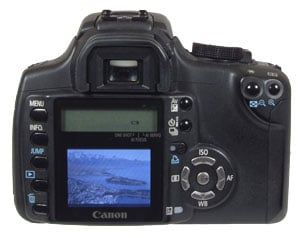 |
The 350D’s new focussing screen provides a noticeably brighter viewfinder than the 300D, although manual focussing isn’t any easier; you also won’t get optional LCD grid lines to aid composition as seen on Nikon’s D70(s).
Canon’s fitted a 1.8in LCD screen with 115,000 pixels. Images and menus look colourful and sharp, but the screen is slightly dim with the default settings. Before long, you’ll want to increase the brightness by a notch.
Probably the biggest complaint though is it’s size. 1.8in may have been acceptable a couple of years ago, but now seems miserly, especially given each of its budget rivals have 2in or even 2.5in screens. Hopefully the 2.5in screen of the high-end EOS-5D will be rolled-out across Canon’s entire DSLR range in the future.
Canon EOS-350D / Rebel XT lens
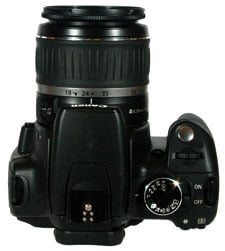 |
The 350D is compatible with both EF and EF-S lenses, and its APS-C sized sensor results in their focal length effectively being multiplied by 1.6 times. Like its predecessor it’s optionally bundled with an EF-S 18-55mm f3.5~5.6 lens, which delivers an effective focal length of 29-88mm. This EF-S kit lens is now labelled with a II, although Canon has stated the optical design is identical to the lens previously bundled with the 300D.
The EF-S 18-55mm is so light you worry it’s not going to perform particularly well, but stop it down a little and it’s actually surprisingly good. Probably the worst aspect is that the front element rotates, which can prove inconvenient for users of polarising filters.
Canon produces a USM version of this EF-S 18-55mm lens which is bundled in certain regions or with special edition packages. Annoyingly Canon’s chosen not to include this USM version with standard 350D kits in Europe and the US.
Admittedly this USM version is otherwise identical to the non-USM lens, including the annoying rotating front element, but it would still have been nice to enjoy its slightly faster and quieter autofocus with the 350D – especially as Canon’s internal goal is to feature USM across its entire lens range. That said, given the modest difference in price between the kit versus the body alone, you’d have to be crazy not to go for the standard lens, even if only to give the camera better resale value.
UPDATE: Not sure which general-purpose lens to buy for your EOS 350D? Check out our video tour which discusses four popular choices from the budget EF-S 18-55mm to the stabilised EF-S 17-85mm. The camera we used in the video was an EOS 400D, but all the lenses work on the EOS 350D and the comments equally apply. If you’re interested in seeing results from each model along with a detailed discussion of their pros and cons, check out our full Canon kit lens group test.
Canon EOS 350D / Rebel XT sensor
Many people assumed Canon would simply re-use the EOS-20D’s sensor for the 350D, but the company has developed an entirely new sensor for the budget camera. It’s an 8.0 megapixel CMOS design which measures 22.2 x 14.8 mm and delivers images with 3456 x 2304 pixels. The sensitivity can be set between 100 and 1600 ISO.
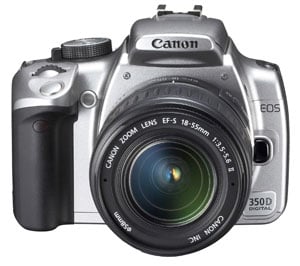 |
In contrast the 8.2 megapixel CMOS sensor of the 20D measures 22.5 x 15.0 mm and delivers images with 3504 x 2336 pixels. In practice the fractionally larger sensor of the 20D doesn’t make any noticeable difference to the effective multiplication of lens focal lengths which remains 1.6 times. The additional pixels of the 20D sensor also make little if no difference to captured detail – see results section later.
|
You’d therefore be forgiven for believing 8.0 versus 8.2 megapixels is purely a marketing decision, but there’s one important technical difference between the two sensors. The 20D sensor can read data much faster, allowing it to deliver a 5fps continuous shooting mode, whereas the 350D sensor’s slower throughput limits it to 3fps. This is still an improvement over the 300D’s continuous shooting speed of 2.5fps though, and the buffer has also been increased considerably – see later.
A quick note on pixel size and noise levels: the 300D employed a 6.3 megapixel CMOS sensor measuring 22.7 x 15.1mm and delivered images with 3072 x 2048 pixels. Clearly the individual pixels on both the 350D and 20D are physically smaller which would normally raise concerns over increased noise levels. Canon has however redesigned the pixels on both sensors so their actual photo-sensitive area is bigger than their predecessors. As a consequence, noise levels shouldn’t be compromised – see results page.
Files and memory
Images can be recorded at three resolutions, each with the choice of two JPEG compression levels. There’s also an option to record a RAW file, with or without a best-quality JPEG; unlike the 300D, this accompanying JPEG is recorded as a separate file. Using the full resolution and best-quality JPEG setting, our test image files ranged from 1.4 to 6.5MB, although the vast majority worked out between 3 and 3.5MB each.
The 350D records images onto Type-I or Type-II Compact Flash cards and supports FAT-32 formatting for those larger than 2GB in size; the slot can also accommodate Microdrives. The camera sports a USB-2.0 port for copying images onto a PC or Mac and comes with Canon’s Digital Photo Professional software to process RAW files.
Image processing and handling speed
Behind the scenes the 350D’s powered by the same DiG!C II image processor as the 20D, 1D Mark II and 1Ds Mark II bodies. The image processor is a crucial part of every digital camera, not just because of its impact on picture quality, but also the speed with which data is handled in the camera.
|
As proved in Canon’s higher-end bodies, the DiG!C II is a speedy operator, rapidly processing raw data into JPEGs and keeping the shooting buffer clear for more shots. The effect of the DiG!C II in the 350D is immediately apparent when it comes to continuous shooting. As mentioned earlier, the 350D enjoys a slightly faster continuous shooting speed compared to its predecessor – 3fps versus 2.5fps – but it’s the number of shots the camera can take before slowing down which demonstrates the power of the image processor.
Canon officially quotes a buffer of 14 JPEGs on the 350D compared to just four on the 300D, but depending on the subject matter it could actually work out as many more. We framed our standard ISO 12233 optical test target with each camera, set them to their best quality JPEG settings, then held the shutter release, counting the frames until any bottlenecks slowed the shooting rate or stopped it altogether. To ensure the CF card wasn’t the limiting factor we used a fast SanDisk Ultra II 1GB card.
The 350D fired off a respectable 41 shots in 15 seconds before it began to slow, but even then, only by a small degree; it also seemed happy to continue shooting at a respectable rate for much longer still. Each image measured an average of 2.31MB, and after shooting 41 of them, it took just five seconds for the camera to complete writing to the card.
The 300D performed in practice as it does on paper, firing four frames in roughly a second and a half before slowing significantly. During the same period of 15 seconds, it captured just 13 JPEGs, each measuring an average of 1.98MB. After letting go of the shutter at the 15 second point, the camera took a further 25 seconds to finish writing to the card.
Admittedly the file sizes produced above were slightly smaller than the average day-to-day shots taken with each camera, but it still illustrates a big difference between data handling on the two models. The older 300D almost stalls after its four-shot buffer is full and takes an age to finish writing images to its card. In contrast, the fast DiG!C II processor in the 350D clears its buffer as you’re shooting, allowing faster continuous shooting and for many more shots.
This processing speed extends to other areas of the camera including image playback. Using the same ISO test image above, the 350D opened images in Play mode about twice as fast as the 300D. Thumbnails were also much quicker, with nine images on the 350D taking 1.8 seconds to load compared to over four seconds on the 300D. It doesn’t sound that big a deal when written down, but feels very different in practice.
The biggest difference of all in terms of speed though is the startup time. This was an area where the older 300D could become infuriating, taking two or three seconds before allowing you to take your first shot. It also took a similar amount of time to wake up after the power-saving had kicked-in. Again this may not sound like a big deal when written down, but this delay often proved excruciating as opportunist compositions would sail off into the distance. This was one important area where the Nikon D70 took the lead.
With the 20D, Canon brought a virtually instant 0.2 second startup time to it’s semi-pro range, and has now thankfully also applied it to the 350D. Starting up, or waking up almost ten times faster than its predecessor could be enough alone for many people to seriously consider the 350D – it’s considerably more responsive in every respect.
Outdoor scene – Canon EOS-350D / Digital Rebel XT comparison
Canon EOS 350D results continued…
Outdoor / Resolution / Noise / Corner sharpness / Fringe and macro / Geometry / Vignetting
|
|
